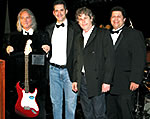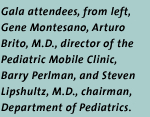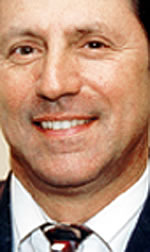
A resource replicated around the world
Alum Creates First Craniofacial Skull Model
Library
![]() ow
do you show a parent what is happening to the tiny, malleable skull
that lies beneath the skin of their infant?
ow
do you show a parent what is happening to the tiny, malleable skull
that lies beneath the skin of their infant?
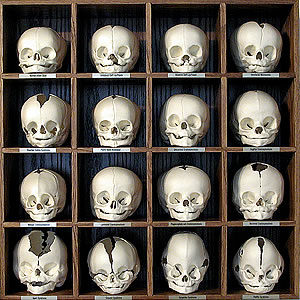 |
||
It’s a question that Chad Perlyn, M.D. ’99, would ask himself after emerging from the lengthy surgeries required to repair craniofacial defects. “When parents have a child with a complex medical problem, it’s so hard for them to visualize,” he says. His solution? To create a craniofacial skull model library that would show what the damaged skull looked like—and how it would be repaired.
Perlyn and Jeff Marsh, M.D., formerly an attending physician with Perlyn in his residency program at Barnes-Jewish Hospital at Washington University in St. Louis, viewed more than 3,000 scans of actual patient syndromes before settling upon the 15 most common craniofacial diagnoses. In a painstaking process using custom sterolithography, Marsh and Perlyn created the library with Andy Christensen of Medical Modeling, a medical imaging company. The process took three years, and Perlyn and the other physicians involved in the project received no financial compensation.
“This is truly a labor of love for them,” says Seth Thaller, M.D., D.M.D., chief of UM’s Division of Plastic and Reconstructive Surgery.
The library is the world’s first comprehensive—and, more importantly, reproducible—set of such models. “They are a superb tool for explaining the nature of why surgery is often needed and for illustrating how the surgery is done,” says Perlyn. A normal skull is included with the 15 abnormal skulls so that health care providers can easily demonstrate the goals of surgery or other treatments to the families. “It’s a tremendous thing to show the parents. Parents feel very guilty when they have a child with a facial deformity, so this helps the parents feel like they’re participating in their treatment,” Thaller says.
More than 70 model libraries have been purchased or donated across the world. UM/Jackson Memorial Medical Center has one, thanks to a donation by John Morell & Company.
“UM has a long history of providing outstanding care to children with facial deformities, and I am certain this set will be well utilized,” Perlyn says.
| Lucky Brand Jeans Foundation Gala
Miami natives Gene Montesano and Barry Perlman created the foundation to bring happiness, comfort, and hope to disabled children. The foundation is committed to improving the quality of life and well-being of children. Comedian Paul Rodriguez was celebrity host, and Kenny Loggins was the surprise musical guest. In addition to an evening of music, guests were treated to an auction, including several celebrity-autographed guitars. |
Toppels’ gift
will advance pediatric medicine
A Commitment to Giving Back
![]() $3
million gift from the Boca Raton-based Toppel Family Foundation will
help create the Toppel Chair in Pediatric Hematology/Oncology at the
Miller School of Medicine. Patricia and Harold Toppel describe their
philanthropic philosophy as a “commitment and desire to give back
to the same community that has given so much to us.”
$3
million gift from the Boca Raton-based Toppel Family Foundation will
help create the Toppel Chair in Pediatric Hematology/Oncology at the
Miller School of Medicine. Patricia and Harold Toppel describe their
philanthropic philosophy as a “commitment and desire to give back
to the same community that has given so much to us.”
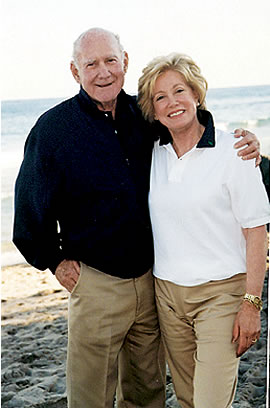 |
||
 |
||
“This gift will allow our department to recruit one of the finest specialists in the field,” says Steven Lipshultz, M.D., chairman of the Department of Pediatrics. “The generosity of the Toppel family will allow us to expand both clinical care and research in our sickle cell program, one of the largest in the country, as well as our pediatric oncology/ hematology and bone marrow transplant programs.” The Toppels are actively involved in University affairs and support numerous projects, including the Toppel Career Planning and Placement Center and the Bascom Palmer Palm Beach Building Fund. In addition, the couple support a variety of youth, early childhood, and higher education programs in Palm Beach County. The Toppels provided the initial funding for the Champs After School Program, which has been successful in improving the academic success of nearly 4,000 at-risk students at 40 Palm Beach sites.
The Toppels were recently honored with the Sun-Sentinel’s prestigious Community Service Award as well as the 2004 Spirit of Youth Award from the Palm Beach Education Foundation.
As the parents of four grown children and grandparents to six, the Toppels maintain a high level of interest in programs that support childhood development and pediatric health care. Patricia Toppel, a UM alumna and trustee, credits John G. Clarkson, M.D., senior vice president for medical affairs and dean of the Miller School, “and what he has accomplished at the medical school” as one of the reasons this opportunity captured their attention and support.
 The credit for their philanthropic philosophy, however,
is given to their parents. Harold Toppel’s father owned a mom-and-pop grocery store
in which he learned the skills that would impact his entire life and,
eventually, the communities in which he lived. As founder of Pueblo Supermarkets
in Puerto Rico and Xtra Super Food Centers in South Florida, Harold followed
his parents’ example of sharing one’s successes with the
community and people who helped build them.
The credit for their philanthropic philosophy, however,
is given to their parents. Harold Toppel’s father owned a mom-and-pop grocery store
in which he learned the skills that would impact his entire life and,
eventually, the communities in which he lived. As founder of Pueblo Supermarkets
in Puerto Rico and Xtra Super Food Centers in South Florida, Harold followed
his parents’ example of sharing one’s successes with the
community and people who helped build them.
Today Harold and Patricia dedicate their time and know-how to their family business, Toppel Partners. As president of The Toppel Family Foundation, Patricia helps to guide the next generation of her family with a results-based approach to philanthropy.
“Thanks to the foresight and generosity of the Toppels, the Department of Pediatrics will be able to expedite clinical and research activities that will lead to exciting new medical breakthroughs and treatments for a variety of hematology diseases,” says Clarkson.
Adds Lipshultz, “Because of the vision and generosity of the Toppel family, children with cancer and their families will now have greater reason to believe and hope for better outcomes.”
The Toppels find their association with the institution to be very rewarding, commenting, “We continue to be proud of our association with the University of Miami and all it does to benefit our community.”
Carlins Inspire Others to Make a Difference
Advancing the State of the Art in Thoracic Medicine
![]() he
respected humanitarian Albert Schweitzer observed, “Whatever
you received more than others … you must not take as a matter of
course. In gratitude for your good fortune, you must render some sacrifice
of your own life for another life.”
he
respected humanitarian Albert Schweitzer observed, “Whatever
you received more than others … you must not take as a matter of
course. In gratitude for your good fortune, you must render some sacrifice
of your own life for another life.”
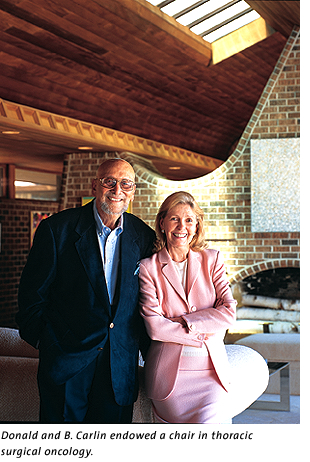 B. and Donald Carlin believe so strongly in that concept that they have
endowed a $2.5 million chair in thoracic surgical oncology at the Miller
School of Medicine. The B. and Donald Carlin Chair in Thoracic Surgical
Oncology recognizes the outstanding contributions to the field of thoracic
medicine and the overall excellence of UM thoracic surgeon Richard Thurer,
M.D., who is the initial chair holder.
B. and Donald Carlin believe so strongly in that concept that they have
endowed a $2.5 million chair in thoracic surgical oncology at the Miller
School of Medicine. The B. and Donald Carlin Chair in Thoracic Surgical
Oncology recognizes the outstanding contributions to the field of thoracic
medicine and the overall excellence of UM thoracic surgeon Richard Thurer,
M.D., who is the initial chair holder.
The genesis of the gift stemmed from B. Carlin’s own childhood struggles with pleurisy and three lung sur-geries by the age of 10. Three years ago Thurer operated on her and successfully removed her lung cancer. Today she is a proud cancer survivor and “feeling wonderful.” She wistfully reflects upon the struggle several close friends of hers, including former Barry University President Sister Jeanne O’Laughlin, have had in dealing with lung cancer. “Don and I decided to do something positive in the hope of making a critical difference in fighting this disease,” she said. As a former longtime smoker, Carlin knows firsthand “the importance of educating people, particularly young people, to the risks of smoking. Much more attention needs to be paid to screening, including the value of a chest X-ray.”
Carlin believes she and her husband, Don, president of Kahn-Carlin and Co., a Miami- based insurance company, have a unique responsibility and opportunity to help. “Both of us have been very blessed, and the world has been good to us,” she says. “We believe that if you have a little, you should give some. If you have a lot, then give more.”
![]()
Alan Livingstone, M.D., chairman of the DeWitt Daughtry Family Department of Surgery, says, “The Carlin Chair is a very meaningful expression in recognizing the accomplishments of Dr. Richard Thurer, an esteemed faculty member who has contributed greatly to the field of oncologic thoracic surgery for over three decades.”
The creation of the chair will provide the resources necessary to help organize clinical and research activities in a more effective way by supporting research, the clinical faculty, and promoting lung cancer activities.
W. Jarrard Goodwin, M.D., F.A.C.S., director of the UM/Sylvester Comprehensive Cancer Center, notes, “Having the unique benefits of an established chair to attract a truly outstanding surgeon/ oncologist to follow in Dr. Thurer’s footsteps will be critically important in continuing the accomplishments of the program and expanding its outreach to patients in need. It is heartwarming to see the appreciation and concern B. and Donald hold for Dr. Thurer and the importance they attach to ensuring that the high-quality medical care and compassion toward his patients continues.”
As for their response, B. Carlin simply but eloquently states, “There are so many worthy causes out there. Hopefully our gift will inspire others to reach out and make a difference.”
Training the next generation of researchers
Fuentes Establish Graduate Program in Cancer Biology
![]() hanks
to a $1.6 million gift from UM trustee David Fuente and his wife, Sheila,
the University of Miami Sylvester Comprehensive Cancer Center will launch
a multidisciplinary graduate program in the biology of cancer.
hanks
to a $1.6 million gift from UM trustee David Fuente and his wife, Sheila,
the University of Miami Sylvester Comprehensive Cancer Center will launch
a multidisciplinary graduate program in the biology of cancer.
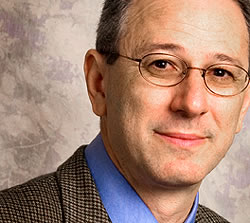 |
||
W. Jarrard Goodwin, M.D., F.A.C.S., director of UM/Sylvester, says the program in cancer biology will “offer a multidisciplinary approach involving several departments built around a cadre of investigators with a shared interest in the biology of cancer and in basic and translational research as it relates to cancer.”
The graduate program will be directed by David Helfman, Ph.D., a distinguished scientist recently recruited from the prestigious Cold Spring Harbor Laboratory in Long Island, New York. In addition to his leading research work in the biology of cancer, Helfman helped establish an innovative and highly successful interdisciplinary graduate program at Cold Spring Harbor. He is the second of six senior scientists to be recruited to UM/Sylvester.
“The Sheila and David Fuente Graduate Program in Cancer Biology will provide an innovative and multidisciplinary training program for the next generation of cancer researchers,” Helfman says.
“Thanks to the foresight and generosity of the Fuentes, the next generation of cancer biologists will be exposed to clinical aspects of cancer in addition to basic research,” he adds. “This will greatly facilitate our overall objective to train students for careers in translational cancer research.”
![]() ALUMNISPOTLIGHT|DENNIS
AGLIANO
ALUMNISPOTLIGHT|DENNIS
AGLIANO
Practicing a Noble Profession
NAME: Dennis Agliano, M.D., F.A.C.S.; Class of 1968 PROFESSION: Board-certified head, neck, and cosmetic surgery. Currently in private practice in Tampa, Florida. ACCOMPLISHMENTS: Established the expert witness program in Florida, which became the model that was adopted by the American Medical Association for a similar national program. Distinguished alumnus, University of Miami. Hillsborough County, Florida (Tampa) Physician of the Year in 1998 and 2004. Currently president of the Florida Medical Association; past president of the Hillsborough County Medical Association, 1995. Received the Chair Award from the Board of Governors, American Academy of Otolaryngology, in 2003. HOBBIES:Golf and tennis. MEDICAL SCHOOL EXPERIENCE/ RECOLLECTION: I fondly remember my medical school days over at the Veterans Hospital, now The Biltmore Hotel. We had a great class with so many of my classmates going on to distinguish themselves in a variety of fields that it’s impossible to name them all. A few that come to mind include John Clarkson, Tully Patrowicz, and Richard Ellenbogen. George Paff was one of our favorite anatomists. He was a dynamic guy and an outstanding teacher. I was fortunate to have externships in orthopaedics with Dr. Augusto Sarmiento, radiology with Dr. Dave Parks, and plastic surgery with Dr. Gil Snyder. Each summer I would rotate and do my externships. A lot of the guys would go to the VA Hospital and draw blood. I did that for one year, along with several other medical students. In exchange they gave you room and board. PHILOSOPHY: We in medicine are a professional family, and our purpose is to serve our patients, regardless of race, ethnicity, or whether you’re rich or poor. WHY I DO WHAT I DO: I want to serve my fellow man. I think that’s why people become physicians. Practicing medicine is a noble profession, and I can’t think of anything I’d rather do. |
![]()
Marking 50 years of achievement
Medical Alumni Return
to
Celebrate Miller School’s History
![]() ore
than 400 physicians came together in March at the Miller School of
Medicine and The Biltmore Hotel, the original site of the medical school,
for Alumni Weekend 2005—an event where graduates from the inaugural
Class of 1956 joined their fellow alumni to celebrate a tradition of
discovery, knowledge, and healing.
ore
than 400 physicians came together in March at the Miller School of
Medicine and The Biltmore Hotel, the original site of the medical school,
for Alumni Weekend 2005—an event where graduates from the inaugural
Class of 1956 joined their fellow alumni to celebrate a tradition of
discovery, knowledge, and healing.
Alumni Weekend 2005 featured a rich, diverse program of activities, including numerous interactive general information sessions on such topics as Islet Cell Transplantation: From an idea to successful treatment of patients with diabetes; Critical Care: From Resuscitation to Rehabilitation; From the Laboratory to Real Life: Living Longer, Living Better; What’s New in Kidney and Pancreas Transplantation; and Preventing Patient Harm: The Role of Patient Safety.
 |
|
Freshman Pinning Ceremony
Continuing a tradition that began at the medical school in 2001, alumni and fourth-year students presented pins to the 166 members of the Class of 2008. The ceremony, one of the most important events for first-year medical students, is their official welcome to the Miller School of Medicine and to the profession of medicine.
Guest speaker Kevin Soden, M.D., national medical correspondent for NBC and a regular contributor to the Today show, combines wit with a humanistic approach to the art of medicine. “The key to being a good doctor is the ability to ask the probing questions that get to the heart of a patient,” Soden said.
Scott Jaban, M.D. ’77, and his wife, Hilary, recently established an endowment at the medical school to fund a distinguished speaker for the ceremony. “Hilary and I were most interested in enriching the lives of medical students at UM,” says Jaban.
Alumni Donors Recognized for Their Commitment
The Scholarship Donor Recognition Luncheon brought together current medical students, who have received scholarships and grants from the Medical Alumni Association through the John K. Robinson Fund, to personally thank alumni who have generously supported them. Citing the increasingly high cost of attending medical school, estimated to exceed $200,000 for four years, John G. Clarkson, M.D. ’68, senior vice president for medical affairs and dean, announced that creating additional scholarship resources is a top priority of the medical school.
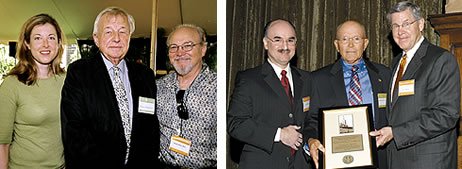 |
||
 |
||
In recognizing donors who attended the luncheon, Clarkson thanked “all the alumni and friends who have given through the John K. Robinson Fund, which has always been the largest source of aid to support medical scholarships with more than $75,000 annually.”
In addition to scholarships, the John K. Robinson Fund provides grants to help medical students pursue their research, leadership, and educational goals with fewer financial barriers.
So far, $7,000 has been awarded to deserving students,” says Ryan Madanick, M.D. ’98, selection committee chair for the John K. Robinson Grant for Student Initiatives and assistant professor of clinical medicine at UM.
Before the class reunion dinners and Hall of Fame Award Banquet, a plaque was dedicated at the site of the original entrance of the UM School of Medicine at the Biltmore. The hotel was commandeered as a hospital during World War II by the Miami Veterans Administration Hospital, and the medical school was born in the hotel’s original servants’ quarters. For 17 years the Anastasia Building at the hotel would serve as the primary teaching site for the University’s medical students.
![]()
“In order to appreciate where the Miller School of Medicine is today, as one of the nation’s leading research and medical institutions, one must understand our earliest roots to fully grasp how far this institution has come in such a relatively short period of time,” said Clarkson.
School’s First Class President Honored
The Anastasia Award was presented to Norman Kenyon, M.D. ’56, the medical school’s first class president. The award honors alumni who through the practice of medicine exemplify professionalism, humanity, and citizenship, bringing distinction to themselves, alumni, and the medical school.
Kenyon serves as chair of the board at Doctors Hospital in Coral Gables, Florida. A member of the Iron Arrow and Alpha Omega Alpha honor societies, he has authored numerous publications. His current research focuses on islet cell transplantation.
Hall of Fame Induction
As the Classes of 1965, 1975, 1985, and 1995 held their class reunion dinner, other alumni and guests attended the Hall of Fame Award Banquet. The School of Medicine honored Larry Gilstrap, M.D. ’70, and Julie Korenberg, M.D., Ph.D. ’79, with induction into the Hall of Fame. Gilstrap, chair of the obstetrics and gynecology department at the University of Texas at Houston, has had a significant impact on the practice of maternal fetal medicine. Korenberg, vice chair of research in the department of pediatrics and the Brawerman Chair of molecular genetics at UCLA, is internationally recognized for her major contributions in chromosomal genetics.
| Carlin Photo by Donna Victor, Helfman Photo by Biomedical Communications and Alumni Weekend Photos by Pyramid Photographics |
|
|
|
|
|
|
|
|
